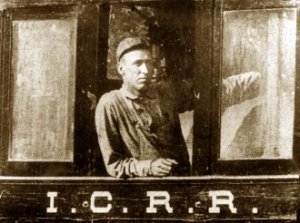
A 1902 political cartoon depicts an attempt by Cuban farmers to export sugar cane to the United States via a reciprocity agreement, rebuffed by tariff-wielding sugar growers. Though the gate to reciprocity is blocked, the doors to annexation swing open, and Puerto Rico, symbolized on the far right, has entered through them. / Udo J. Keppler, Library of Congress.
Excerpt from Ground Down to Molasses: The Making of an American Folk Song by David Byrne (bostonreview.net):
The Brazos River flows from Texas’s northern tier, at the confluence of the Salt Fork and Double Mountain Fork. It then flows south for 840 miles through east central Texas before emptying into the Gulf of Mexico. The story of “Ain’t No More Cane on the Brazos” is a tale of confluence as well, with a mystifying series of tributaries. As it mutates, the song can be located at certain way stations, but the origin of “Ain’t No More Cane” is a grand vanishing act.
Here it is, 1933, almost 200 years to the day since the Molasses Act was passed. John and Alan Lomax are lugging their 315-pound disk recorder around Texas, talking their way onto prison plantations and making the first recordings of Texas work songs. The earliest known performance of “Ain’t No More Cane” is attributed to a group of prisoners at Central Unit on the Brazos—Ernest Williams, Iron Head Baker, and anonymous “others.”
But it ain’t no more cane on the Brazos
yeah yeah yeah
they done grind it all in molasses
oh, oh, oh.
This is generally regarded as the lyrical model for the versions to come, but it cannot be considered by itself. Another work gang singing the song “Go Down, Old Hannah” complicates things. There is no Brazos in it, but it is essential to understanding later renditions of “Ain’t No More Cane.”
As Alan Lomax wrote eloquently, “Go Down, Old Hannah” is strident and apocalyptic, a choral fury aimed upward at the unrelenting Texas sun—old Hannah—and downward at the circumstances that could trap a man in the hell of Brazoria County. You could force yourself to cut cane all day under the spell of this terrifying song. You could sing it, too, while driving a rusted stake into your oppressor’s heart. Here are the opening lyrics, with the choral phrases emphasized:
old Hannah / well, well, well / you’re turning red / you’re turning red / well I looked at old Hannah / it was turning red / well I looked at my partner / well, well, well / he was almost dead / he was almost dead.
Scores of online folklorists and living-room strummers attribute “Ain’t No More Cane” to Huddie Ledbetter—one gentleman sings a jumped-up version at Ledbetter’s gravesite—but Ledbetter never recorded it. What he did record was “Go Down, Old Hannah.” Ledbetter is associated more closely with Louisiana’s Angola prison, but he had also done time at Central State, the same Brazos prison farm where Iron Head Baker and Ernest Williams were locked up. He starts his version with the usual invocation of the sun:
Don’t you rise no more / and if you rise in the morning / bring judgment sure / it was soon one morning / when the sun did rise / and I was thinking ’bout my good-looking baby / I would hang my head and cry / go down old Hannah / please don’t rise no more / and if you do rise in the morning / set the world on fire.
Ledbetter is well into the song before the Brazos, unnamed, appears: “If you had been on the river / somewhere in 1910 / they was driving the woman / just as hard as they do the men.”
When Ledbetter is finished singing, the recording continues. Someone, I presume it is John Lomax, says to Ledbetter: “First time I ever heard you sing that many verses.” And Ledbetter replies, “Well, you can just put, you know, just make ’em right on up, you know.”
We should run from the notion of seminal documents in such settings. What we can say is that one recording introduces the disappearance of cane from the Brazos, one song laments the sun, one song laments the sun on the Brazos, and another introduces the Brazos in a lament of the sun. None of these recordings comes close to the original: they just happened to be what was voiced on particular days by particular men when happenstance arrived with a recording machine. Before that, and forever after, Old Rattler is shit out of luck: the trail is too old.
The origins of the specific words disappear along with the songs. Lomax continues the conversation with Ledbetter:
‘Old Hannah is the sun?’
‘Yeah, they call it Old Hannah ’cause it was hot, they just give it a name. . . . Boys talking about Old Hannah. I kept looking and I didn’t see no Hannah . . . but they looked up, said, that’s the sun, that’s all.’
The ancestors of slaves might have known where the name came from. In Hausa, a language widely spoken in areas of West Africa where the slave trade was common, the word for “sun” is “raanaa.”
That African music and oral tradition shaped this music is a truism. It is possible, though, that the language along the Brazos during these years maintained especially close ties to its African roots when compared to what was spoken in areas of the American South that had complied with restrictions on the slave trade.
(more…)






















 by Lyle Lofgren
by Lyle Lofgren




























